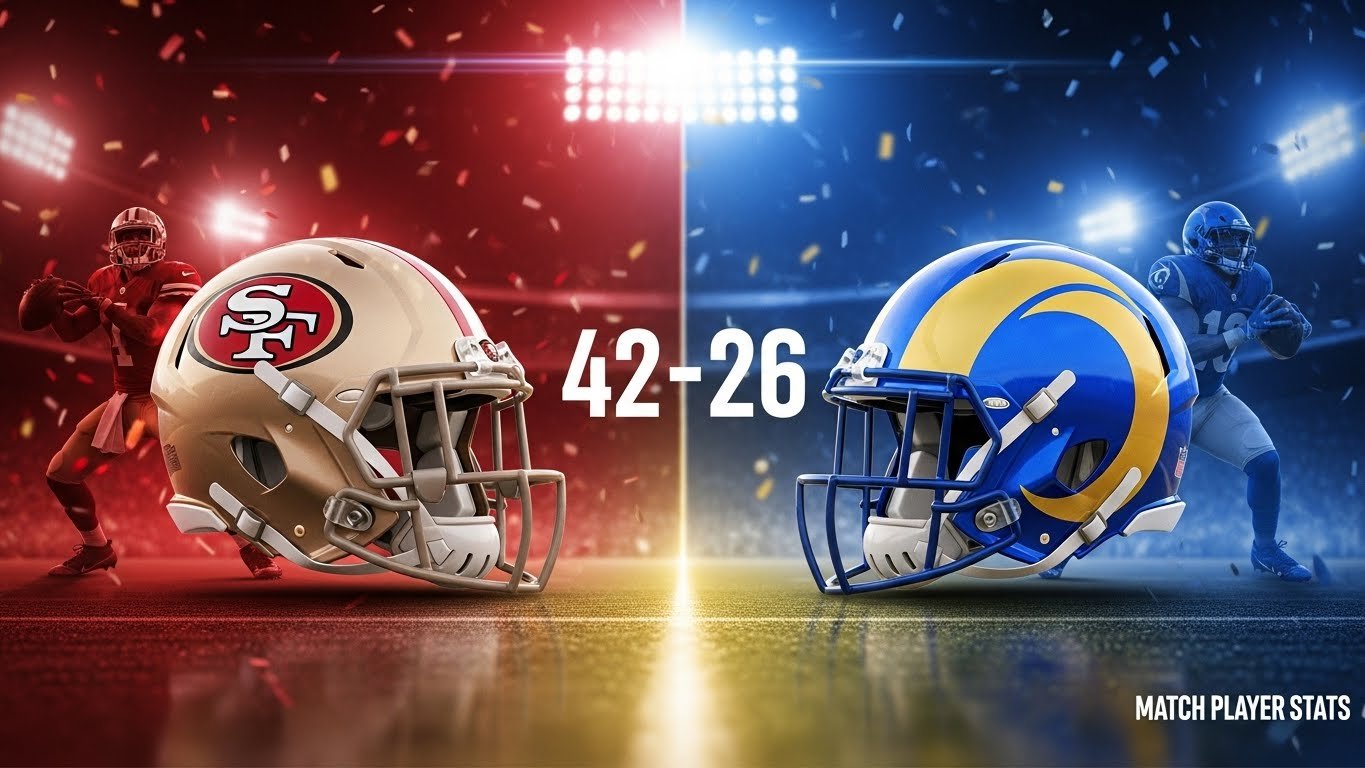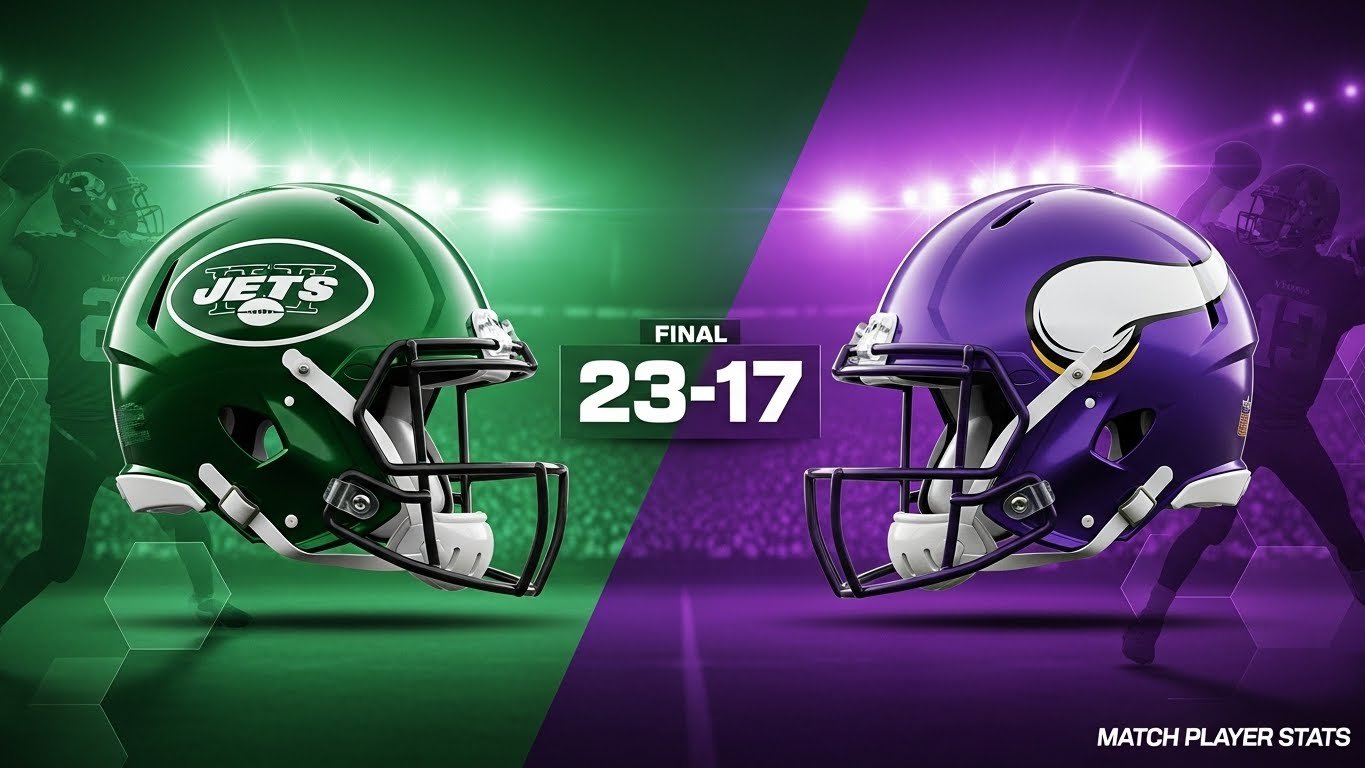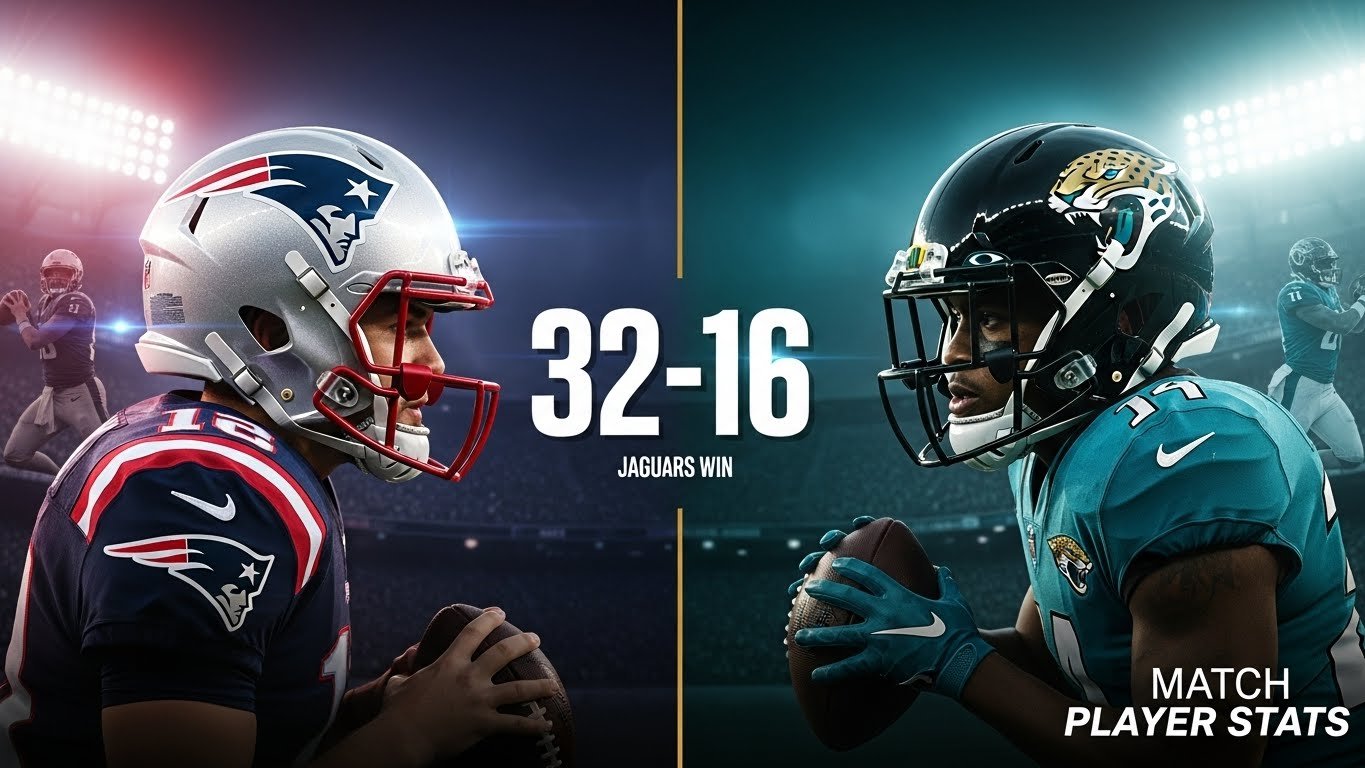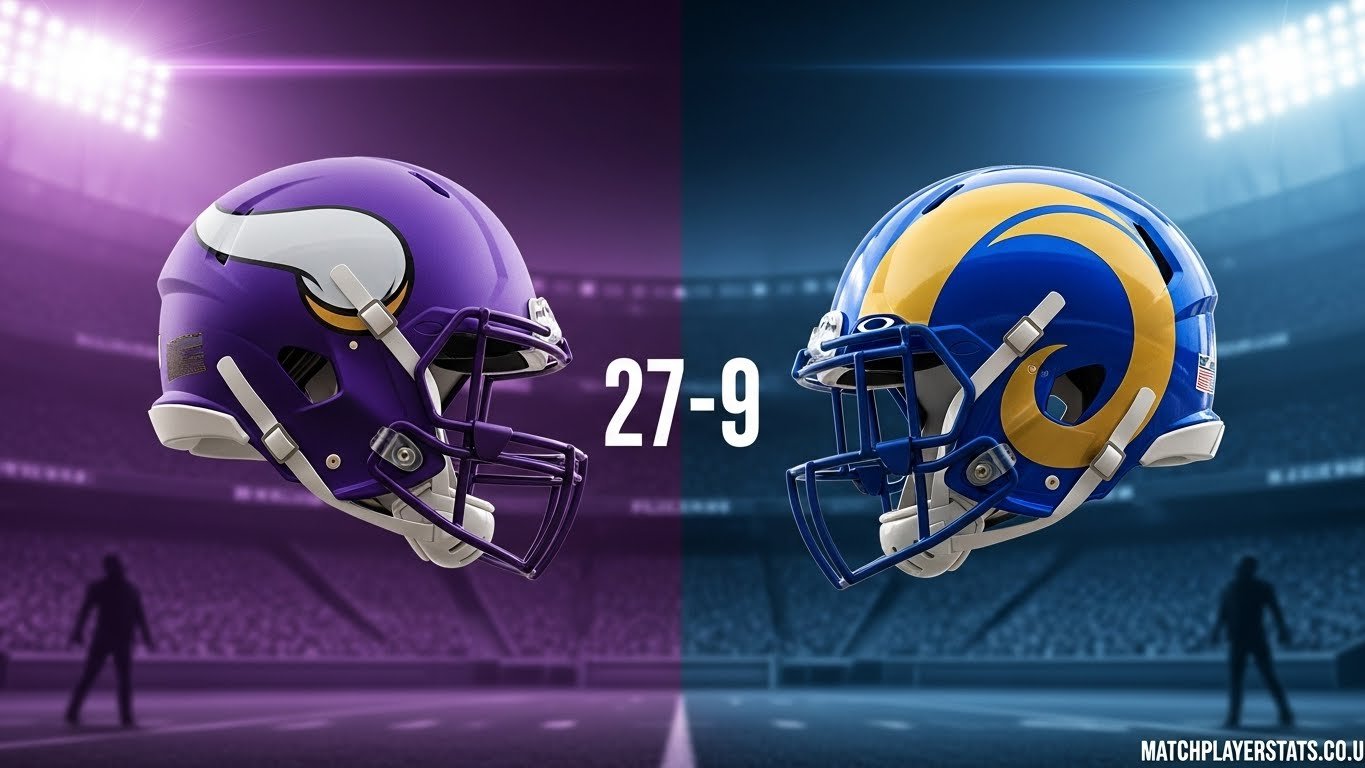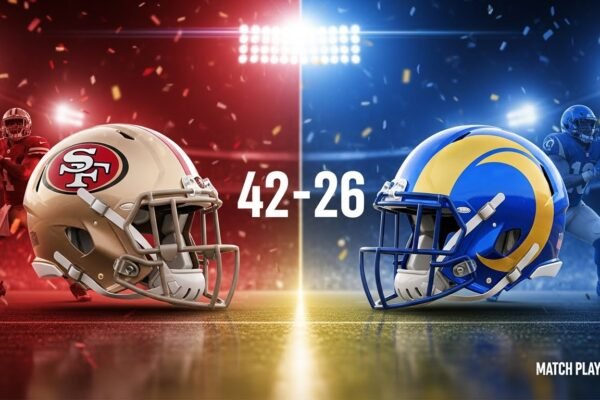

Los Angeles Rams vs Detroit Lions Match Player Stats – (Sept 8, 2024 OT Thriller)
Ford Field witnessed a Sunday Night Football classic on September 8, 2024, and the los angeles rams vs detroit lions match player stats tell a story of how a few key plays and percentage points decided the outcome. Behind the 26-20 overtime score lies a tale of contrasting strategies, record-breaking performances, and clutch moments.
NFL season openers often set the tone for teams, and this rematch of last season’s Wild Card playoff battle didn’t disappoint NFL fans hungry for football’s return.
Game Summary: Lions Overcome Time of Possession Deficit
Final Score: Lions 26, Rams 20 (OT)
| Team Stats | Rams | Lions | Why It Matters |
|---|---|---|---|
| Total Yards | 387 | 363 | Despite fewer yards, Lions won through efficiency |
| Time of Possession | 34:56 | 29:45 | Rams controlled clock but couldn’t capitalize |
| Total Plays | 74 | 61 | Lions did more with fewer opportunities |
| Yards Per Play | 5.2 | 6.0 | The key stat showing Lions’ superior efficiency |
| Rushing Yards | 83 | 163 | Detroit’s ground advantage proved decisive in OT |
| Passing Yards | 304 | 200 | Rams’ air attack couldn’t overcome rushing deficit |
Detroit built a 17-3 lead in the third quarter before Los Angeles mounted a comeback. The Lions tied it with a last-minute field goal, then won on their opening overtime possession behind David Montgomery’s powerful running.
Lions coach Dan Campbell’s post-game analysis emphasized making fewer mistakes than their opponent, highlighting how thin margins often decide NFL contests.
Quarterback Duel: Former Teammates Square Off
The matchup featured quarterbacks facing their former teams, adding extra drama to an already tense contest:
Matthew Stafford (Rams)
- Completions: 34/49 (69.4%)
- Yards: 317
- TD-INT: 1-1
- Passer Rating: 85.2
- Sacks: 2 for 13 yards
- Notable: Interception came in endzone, costing potential points
Jared Goff (Lions)
- Completions: 18/28 (64.3%)
- Yards: 217
- TD-INT: 1-1
- Passer Rating: 85.0
- Sacks: 2 for 17 yards
- Notable: Led game-tying and winning drives when it mattered most
While their passer ratings were nearly identical, the timing of their best (and worst) moments proved crucial. Stafford’s endzone interception cost the Rams potential points, while Goff delivered when the pressure was highest.
Running Back Battle: Committee vs Workhorse
The ground game showcased two completely different approaches:
Lions’ Two-Back System
| Player | Carries | Yards | Avg | TD | Snap % |
|---|---|---|---|---|---|
| David Montgomery | 17 | 91 | 5.4 | 1 | 49% |
| Jahmyr Gibbs | 11 | 40 | 3.6 | 1 | 51% |
| Team Total | 28 | 131 | 4.7 | 2 | 100% |
Rams’ Single-Back Focus
| Player | Carries | Yards | Avg | TD | Snap % |
|---|---|---|---|---|---|
| Kyren Williams | 18 | 50 | 2.8 | 1 | 91% |
| Ronnie Rivers | 2 | 16 | 8.0 | 0 | 9% |
| Team Total | 20 | 66 | 3.3 | 1 | 100% |
Montgomery dominated overtime, including a bruising 21-yard run that set up his own game-winning touchdown. His 86.6 PFF grade showed how effectively he ran behind Detroit’s offensive line.
For casual fans wondering why rushing efficiency matters: The Lions’ 2.1-yard advantage per carry allowed them to stay on schedule offensively, facing manageable third downs and keeping the defense guessing between run and pass.
Montgomery’s Overtime Heroics
- 4 carries, 38 yards in OT
- 21-yard highlight run
- Game-winning 1-yard TD plunge
- Accounted for 54% of OT drive yards
Wide Receiver Showdown: Record Motion vs Breakout Speed
Two receivers with completely different styles dominated this matchup:
Cooper Kupp (Rams)
- Receptions: 14 (tied career high)
- Targets: 21 (42.9% team total)
- Yards: 110
- TD: 1
- Motion Snaps: 42 (record since tracking began)
- Motion Touches: 12 (record since tracking began)
Jameson Williams (Lions)
- Receptions: 5
- Targets: 9
- Yards: 121 (career high)
- TD: 1 (52-yarder)
- Top Speed: 21.5 mph
- PFF Grade: 83.4
Kupp’s pre-snap movement helped Stafford diagnose coverages while creating favorable matchups. Williams showcased the explosive speed that made him a first-round pick, finally delivering on that potential.
Post-game, Williams expressed confidence that this performance was just the beginning of what he could accomplish, while Coach Campbell acknowledged his improvement while noting room for further growth.
Similar dynamics played out in the Chiefs-Ravens season opener later in 2024, where contrasting receiver styles also played a key role in determining the outcome.
Other Key Receivers
| Player | Team | Targets | Catches | Yards | TD | Notes |
|---|---|---|---|---|---|---|
| Tyler Johnson | Rams | 7 | 5 | 79 | 0 | Stepped up after Nacua injury |
| Colby Parkinson | Rams | 5 | 4 | 47 | 0 | Solid Rams debut at TE |
| Sam LaPorta | Lions | 5 | 4 | 45 | 0 | Reliable underneath option |
| Amon-Ra St. Brown | Lions | 6 | 3 | 13 | 0 | Extra defensive attention |
Defensive Playmakers: Game-Changing Moments
Several defenders made crucial statistical impacts that directly affected the outcome:
Top Defensive Performers
| Player | Team | Tackles | Sacks | TFL | QB Hits | INT | PD | PFF Grade |
|---|---|---|---|---|---|---|---|---|
| Aidan Hutchinson | Lions | 5 | 1.0 | 1 | 4 | 0 | 0 | 94.0 |
| Alex Anzalone | Lions | 13 | 0.0 | 3 | 3 | 0 | 0 | 79.0 |
| Jared Verse | Rams | 4 | 1.0 | 1 | 2 | 0 | 0 | N/A |
| Kerby Joseph | Lions | 6 | 0.0 | 0 | 0 | 1 | 1 | 72.1 |
| John Johnson III | Rams | 6 | 0.0 | 0 | 0 | 1 | 1 | N/A |
| Brian Branch | Lions | 7 | 0.0 | 1 | 0 | 0 | 3 | N/A |
Hutchinson’s game-saving sack as time expired in regulation prevented the Rams from attempting a potential game-winning field goal. His 94.0 PFF grade was the highest of any player in the game.
Rams rookie Jared Verse impressed with a 33% pass rush win rate and 6 QB pressures in his NFL debut, showing why LA selected him in the first round.
Special Teams: Field Position Battle
The kicking game proved perfect on both sides, but field position told a different story:
Kickers:
- Jake Bates (Lions): 2/2 FG (25, 32 yards), 2/2 XP
- Joshua Karty (Rams): 2/2 FG (41, 26 yards), 2/2 XP
Punting Battle:
| Punter | Team | Punts | Avg | Net | In20 | Long |
|---|---|---|---|---|---|---|
| Jack Fox | Lions | 4 | 57.5 | 47.5 | 2 | 67 |
| Ethan Evans | Rams | 3 | 47.0 | 41.0 | 0 | 53 |
For fans who overlook special teams: Fox’s 10.5-yard advantage in net punting gave Detroit consistently better starting field position, a hidden yardage edge that proved crucial in a close game.
Record-Breaking Statistical Notes
This game featured several remarkable statistical achievements:
1. Motion Revolution
- 85.9% of plays (116 of 135) used pre-snap motion
- Highest percentage since Next Gen Stats began tracking (2018)
- Kupp: 42 motion snaps, 12 motion touches, 436 pre-snap motion yards
- All three figures set records for a single player
2. Speed Demons
- Williams reached 21.5 mph on a 36-yard reception
- Previously led NFL by hitting 20+ mph on 14.8% of touches
- This pattern of explosive plays has continued across the NFL in 2024, as seen in the 49ers-Chiefs matchup where similar speed advantages created big plays
3. Historic Defensive Start
- Anzalone: First Lion with 10+ tackles and 3+ TFLs in season opener
- Hutchinson: 37% pass rush win rate (elite figure)
- Verse: 33% pass rush win rate (highest among rookies in Week 1)
4. Contrasting Strategies
- Rams relied heavily on starters (Stafford, Kupp: 100% of snaps)
- Lions used balanced rotation (Montgomery/Gibbs near 50/50 split)
- Similar to how the Cowboys approached their 2024 matchup with the Browns by rotating key players to maintain freshness
5 Key Stats That Decided The Game
The numbers reveal why Detroit prevailed despite Los Angeles controlling possession:
- Rush Yard Differential: Lions outrushed Rams 163-83 (+80)
- Yards Per Carry: Lions 5.3 vs Rams 3.6 (+1.7)
- Red Zone TD%: Lions 66.7% (2/3) vs Rams 33.3% (1/3)
- Third Down Efficiency: Lions 46.2% vs Rams 41.7% (+4.5%)
- Net Punt Average: Lions 47.5 vs Rams 41.0 (+6.5)
These efficiency metrics matter more than total yardage or time of possession. The Lions maximized their opportunities while the Rams left points on the field.
FAQs: Los Angeles Rams vs Detroit Lions Match Player Stats
Who had the best statistical performance in this game?
While Cooper Kupp led with 14 receptions, Aidan Hutchinson earned the highest PFF grade (94.0) thanks to his game-saving sack. Statistically, Jameson Williams made the biggest impact per touch, averaging 24.2 yards per reception with a career-high 121 yards.
How did the quarterbacks perform against their former teams?
Matthew Stafford posted more volume (34/49, 317 yards) while Jared Goff was more efficient (18/28, 217 yards). Both threw 1 TD and 1 INT with nearly identical passer ratings, but Goff led the crucial game-tying and winning drives.
Which statistical advantage mattered most for the Lions?
Detroit’s rushing efficiency (5.3 YPC vs 3.6 YPC) proved decisive, particularly in overtime when David Montgomery gained 38 yards on 4 carries to drive the winning touchdown.
What NFL record was broken during this game?
This game set a Next Gen Stats record for pre-snap motion usage at 85.9% of plays. Cooper Kupp also set individual records with 42 motion snaps and 12 touches while in motion—the most by any player since tracking began.
Which rookie showed the most statistical promise?
Rams OLB Jared Verse impressed in his NFL debut with 4 tackles, 1 sack, and a 33% pass rush win rate. Lions CB Terrion Arnold also performed well, recording 8 solo tackles while playing 97% of defensive snaps.
The Statistical Story of an Overtime Classic
When you dig into the los angeles rams vs detroit lions match player stats, you discover how tiny efficiency edges add up to victory in today’s NFL. While Los Angeles controlled the clock and ran more plays, Detroit capitalized on their opportunities with explosive gains and clutch execution.
Montgomery’s bruising overtime runs, Williams’ career-best receiving performance, and Hutchinson’s perfectly timed sack all highlight how individual excellence in key moments often decides close games.
These player statistics don’t just explain who won—they tell us why Detroit prevailed despite statistical disadvantages in several traditional categories. In a league where margins are razor-thin, the Lions’ superior efficiency in crucial situations proved the difference in this 26-20 overtime thriller against the los angeles rams.




